Product Images Quetiapine
View Photos of Packaging, Labels & Appearance
Product Label Images
The following 14 images provide visual information about the product associated with Quetiapine NDC 71610-702 by Aphena Pharma Solutions - Tennessee, Llc, such as packaging, labeling, and the appearance of the drug itself. This resource could be helpful for medical professionals, pharmacists, and patients seeking to verify medication information and ensure they have the correct product.
10 - Table 10
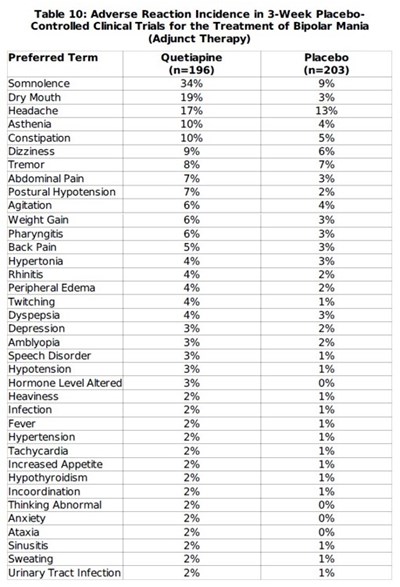
This is a table showing the incidence of adverse reactions in patients with bipolar disorder who were given quetiapine as adjunct therapy. The table compares the incidence of these reactions to a control group who received a placebo instead of quetiapine. The preferred terms of the adverse reactions and their incidence percentages are listed in the table. Some of the most common adverse reactions associated with quetiapine are somnolence, dry mouth, headache, constipation, agitation, and weight gain. The table provides a useful reference for doctors and patients to understand the likely side effects of quetiapine when used to treat bipolar disorder.*
11 - Table 11
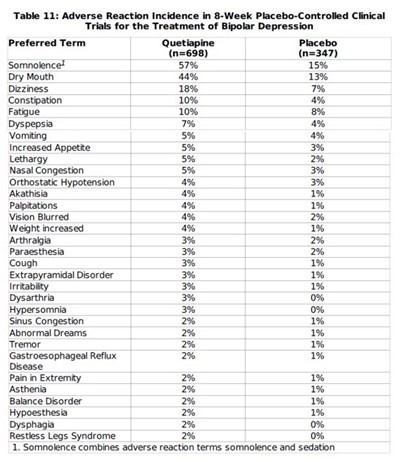
Table 11 shows the incidence of adverse reactions during 8-week placebo-controlled clinical trials for the treatment of bipolar depression using Quetiapine and Placebo. The table includes the percentage of patients who experienced adverse reactions such as somnolence, dry mouth, dizziness, constipation, fatigue, dyspepsia, vomiting, and others. The most common adverse reactions in patients using Quetiapine were somnolence, dry mouth, and dizziness. However, in patients using Placebo, the most common adverse reaction was somnolence, followed by dry mouth and dizziness.*
12 - Table 12
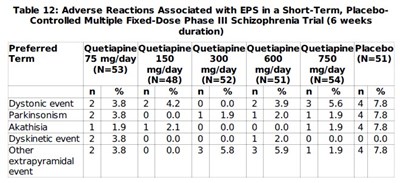
This is a table presenting Adverse Reactions Associated with EPS in a Short-Term, Placebo-Controlled Multiple Fixed-Dose Phase Il Schizophrenia Trial (6 weeks duration). The table presents the preferred term and percentage of patients who experienced an adverse reaction with increasing doses of Quetiapine and Placebo. The adverse reactions are Dystonic event, Parkinsonism, Akathisia, Dyskinetic event, and Other Extrapyramidal event.*
14 - Table 15
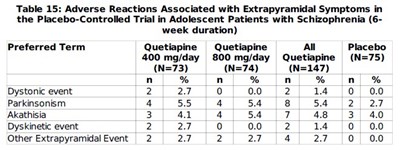
This is a table showing adverse reactions associated with extrapyramidal symptoms in adolescent patients with schizophrenia during a six-week duration placebo-controlled trial. It displays the number and percentage of patients from the groups taking Quetiapine 400 mg/day, Quetiapine 800 mg/day, and Placebo, experiencing dystonic event, Parkinsonism, akathisia, dyskinetic event, and other extrapyramidal events.*
16 - Table 16

This is a table that shows the adverse reactions associated with extrapyramidal symptoms in a placebo-controlled trial of children and adolescents with bipolar mania. The table compares the reactions for three groups based on the dosage of Quetiapine given: 400mg/day, 600mg/day, and a placebo group. The table shows the number of patients and percentages that experienced Parkinsonism, Akathisia, and other extrapyramidal events. The table also states that there were no adverse reactions with the preferred term of dystonic or dyskinetic events.*
8 - Table 8

The text describes a table, Table 8, focused on the incidence of shifts in thyroid hormone levels and TSH in short-term placebo-controlled clinical trials. The incidence of shifts is reported for Quetiapine and Placebo separately for various hormone levels, including Total T4, Free T, Total T3, Free T3, and TSH. The numbers reported show the percentage of patients who experienced shifts in hormone levels or TSH. The table also provides additional information on the definition of shifts used for total T4, free T, total T3, free T3, and TSH. Finally, the table notes that the data includes both Quetiapine and Quetiapine extended-release. Overall, the table appears to be focused on evaluating the impact of Quetiapine on thyroid hormone levels and TSH.*
9 - Table 9
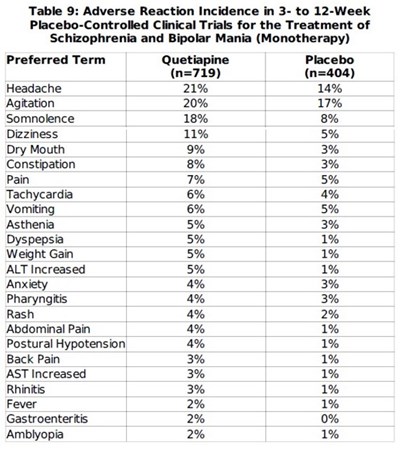
Table 9 shows the incidence of adverse reactions in placebo-controlled clinical trials for the treatment of schizophrenia and bipolar mania. The table lists the preferred terms, such as headache, agitation, somnolence, dizziness, dry mouth, and constipation. It also shows the percentage of patients who experienced adverse reactions for each term while taking Quetiapine versus Placebo.*
* The product label images have been analyzed using a combination of traditional computing and machine learning techniques. It should be noted that the descriptions provided may not be entirely accurate as they are experimental in nature. Use the information in this page at your own discretion and risk.






